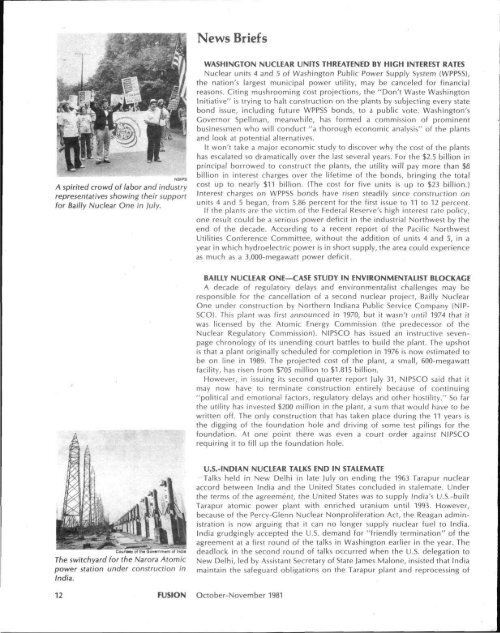Riemann's Contribution to Flight and Laser Fusion
Riemann's Contribution to Flight and Laser Fusion
Riemann's Contribution to Flight and Laser Fusion
- No tags were found...
You also want an ePaper? Increase the reach of your titles
YUMPU automatically turns print PDFs into web optimized ePapers that Google loves.
News BriefsA spirited crowd of labor <strong>and</strong> industryrepresentatives showing their supportfor Bailly Nuclear One in July.WASHINGTON NUCLEAR UNITS THREATENED BY HIGH INTEREST RATESNuclear units 4 <strong>and</strong> 5 of Washing<strong>to</strong>n Public Power Supply System (WPPSS),the nation's largest municipal power utility, may be canceled for financialreasons. Citing mushrooming cost projections, the "Don't Waste Washing<strong>to</strong>nInitiative" is trying <strong>to</strong> halt construction on the plants by subjecting every statebond issue, including future WPPSS bonds, <strong>to</strong> a public vote. Washing<strong>to</strong>n'sGovernor Spellman, meanwhile, has formed a commission of prominentbusinessmen who will conduct "a thorough economic analysis" of the plants<strong>and</strong> look at potential alternatives.It won't take a major economic study <strong>to</strong> discover why the cost of the plantshas escalated so dramatically over the last several years. For the $2.5 billion inprincipal borrowed <strong>to</strong> construct the plants, the utility will pay more than $8billion in interest charges over the lifetime of the bonds, bringing the <strong>to</strong>talcost up <strong>to</strong> nearly $11 billion. (The cost for five units is up <strong>to</strong> $23 billion.)Interest charges on WPPSS bonds have risen steadily since construction onunits 4 <strong>and</strong> 5 began, from 5.86 percent for the first issue <strong>to</strong> 11 <strong>to</strong> 12 percent.If the plants are the victim of the Federal Reserve's high interest rate policy,one result could be a serious power deficit in the industrial Northwest by theend of the decade. According <strong>to</strong> a recent report of the Pacific NorthwestUtilities Conference Committee, without the addition of units 4 <strong>and</strong> 5, in ayear in which hydroelectric power is in short supply, the area could experienceas much as a 3,000-megawatt power deficit.BAILLY NUCLEAR ONE—CASE STUDY IN ENVIRONMENTALIST BLOCKAGEA decade of regula<strong>to</strong>ry delays <strong>and</strong> environmentalist challenges may beresponsible for the cancellation of a second nuclear project, Bailly NuclearOne under construction by Northern Indiana Public Service Company (NIP-SCO). This plant was first announced in 1970, but it wasn't until 1974 that itwas licensed by the A<strong>to</strong>mic Energy Commission (the predecessor of theNuclear Regula<strong>to</strong>ry Commission). NIPSCO has issued an instructive sevenpagechronology of its unending court battles <strong>to</strong> build the plant. The upshotis that a plant originally scheduled for completion in 1976 is now estimated <strong>to</strong>be on line in 1989. The projected cost of the plant, a small, 600-megawattfacility, has risen from $705 million <strong>to</strong> $1,815 billion.However, in issuing its second quarter report July 31, NIPSCO said that itmay now have <strong>to</strong> terminate construction entirely because of continuing"political <strong>and</strong> emotional fac<strong>to</strong>rs, regula<strong>to</strong>ry delays <strong>and</strong> other hostility." So farthe utility has invested $200 mi/lion in the plant, a sum that would have <strong>to</strong> bewritten off. The only construction that has taken place during the 11 years isthe digging of the foundation hole <strong>and</strong> driving of some test pilings for thefoundation. At one point there was even a court order against NIPSCOrequiring it <strong>to</strong> fill up the foundation hole.Courtesy of the Government of IndiaThe switchyard for the Narora A<strong>to</strong>micpower station under construction inIndia.U.S.-INDIAN NUCLEAR TALKS END IN STALEMATETalks held in New Delhi in late July on ending the 1963 Tarapur nuclearaccord between India <strong>and</strong> the United States concluded in stalemate. Underthe terms of the agreement, the United States was <strong>to</strong> supply India's U.S.-builtTarapur a<strong>to</strong>mic power plant with enriched uranium until 1993. However,because of the Percy-Glenn Nuclear Nonproliferation Act, the Reagan administrationis now arguing that it can no longer supply nuclear fuel <strong>to</strong> India.India grudgingly accepted the U.S. dem<strong>and</strong> for "friendly termination" of theagreement at a first round of the talks in Washing<strong>to</strong>n earlier in the year. Thedeadlock in the second round of talks occurred when the U.S. delegation <strong>to</strong>New Delhi, led by Assistant Secretary of State James Malone, insisted that Indiamaintain the safeguard obligations on the Tarapur plant <strong>and</strong> reprocessing of12 FUSION Oc<strong>to</strong>ber-November 1981
















